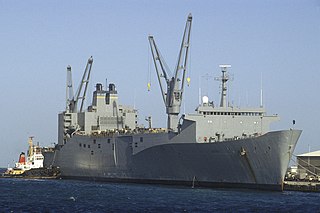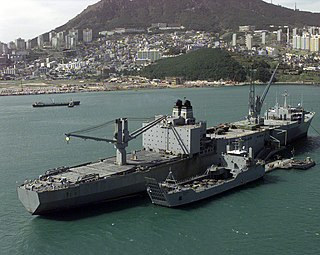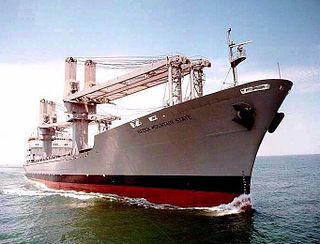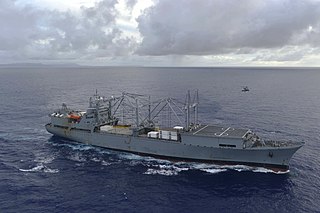
Military Sealift Command (MSC) is an organization that controls the replenishment and military transport ships of the United States Navy. Military Sealift Command has the responsibility for providing sealift and ocean transportation for all US military services as well as for other government agencies. It first came into existence on 9 July 1949 when the Military Sea Transportation Service (MSTS) became solely responsible for the Department of Defense's ocean transport needs. The MSTS was renamed the Military Sealift Command in 1970.

SS Gopher State (T-ACS-4) is a crane ship in ready reserve for the United States Navy. The ship was named for the state of Minnesota, which is also known as the Gopher State.

The National Defense Reserve Fleet (NDRF) consists of "mothballed" ships, mostly merchant vessels, that can be activated within 20 to 120 days to provide shipping for the United States of America during national emergencies, either military or non-military, such as commercial shipping crises.

SS Flickertail State (T-ACS-5) is a crane ship in ready reserve for the United States Navy. She is stationed at Newport News, Virginia and is in ready reserve under the Military Sealift Command (MSC). The ship was named for the state of North Dakota, which is also known as the Flickertail State.

SS Cornhusker State (T-ACS-6) is a crane ship in ready reserve for the United States Navy. She is stationed in Newport News, Virginia under operation control of the Military Sealift Command (MSC). The ship was named for the state of Nebraska, which is also known as the Cornhusker State.

Sealift is a term used predominantly in military logistics and refers to the use of cargo ships for the deployment of military assets, such as weaponry, vehicles, military personnel, and supplies. It complements other means of transport, such as strategic airlifters, in order to enhance a state's ability to project power.

SS Denebola is an Algol-class vehicle cargo ship that is currently maintained by the United States Maritime Administration as part of the Military Sealift Command's Ready Reserve Force (RRF). She was built as a high speed container ship by Rotterdamsche D.D.Mij N.V. in Rotterdam, Netherlands, hull no. 332, for Sea-Land Service, Inc. and named SS Sea-Land Resource, USCG ON 550723, IMO 7325253. Due to her high operating cost, she was sold to the United States Navy in October 1981 as USNS Denebola (T-AK-289).

USNS Pollux (T-AK-290), later T-AKR-290, the fourth United States Navy ship of the name, is an Algol-class vehicle cargo ship that is currently maintained by the United States Maritime Administration as part of the Ready Reserve Force (RRF) as SS Pollux (T-AKR-290).

SS Grand Canyon State (T-ACS-3) is a crane ship in ready reserve for the United States Navy. The ship was named for the state of Arizona, which is also known as the Grand Canyon State.

SS Keystone State (T-ACS-1) is a crane ship in ready reserve for the United States Navy. The ship was named for the state of Pennsylvania, which is also known as the Keystone State.

SS Gem State (T-ACS-2) is a crane ship in Ready Reserve for the United States Navy. The ship was named for the state of Idaho, which is also known as the Gem State.

SS Equality State (T-ACS-8) is a crane ship of the United States Navy. The ship is named for the state of Wyoming, which is also known as the Equality State.

SS Diamond State (T-ACS-7) is a crane ship in the NDRF for the United States Navy. The ship was named for the state of Delaware, which is also known as the Diamond State.

SS Green Mountain State (T-ACS-9) is a crane ship in ready reserve for the United States Navy. The ship was named for the state of Vermont, which is also known as the Green Mountain State.

SS Beaver State (T-ACS-10) is a crane ship in ready reserve for the United States Navy. The ship was named for the state of Oregon, which is also known as the Beaver State.

The Keystone State-class crane ships are seven auxiliary crane ships of the U.S. Maritime Administration Ready Reserve Force. The ships can be quickly activated to support military sea transportation needs. These self-sustaining ships are useful in ports that have limited, damaged or undeveloped port facilities. When activated, they come under operational control of Military Sealift Command.
The Naval Fleet Auxiliary Force is a division of the US Navy. The 42 ships of the Military Sealift Command's Naval Fleet Auxiliary Force are the supply lines to U.S. Navy ships at sea. These ships provide virtually everything that Navy ships need, including fuel, food, ordnance, spare parts, mail and other supplies. NFAF ships enable the Navy fleet to remain at sea, on station and combat ready for extended periods of time. NFAF ships also conduct towing, rescue and salvage operations or serve as floating medical facilities. All NFAF ships are government owned and crewed by civil service mariners. Some of the ships also have a small contingent of Navy personnel aboard for operations support, supply coordination and helicopter operations.
The Type C7 ship(Lancer Class) is a United States Maritime Administration (MARAD) designation for a cargo ship and the first US purpose-built container ship. The vessels were constructed in US shipyards and entered service starting in 1968. As US-built ships they were Jones Act qualified for shipments between US domestic ports. Under the Jones Act domestic US maritime trade is restricted to US-built and flagged vessels of US owners and manned by predominantly US-citizen crews. The last active Lancer container-configured ship was scrapped in 2019. Lancers of the vehicle Roll-on/Roll-off (RO/RO) configuration remain held in the Ready Reserve Force, National Defense Reserve Fleet and the US Navy Military Sealift Command. All are steam powered.

The Type C6 ship is a United States Maritime Administration (MARAD) designation for a container ship developed during the transition years from moving goods by breakbulk cargo to containerization. The Type C4 ships Mariner class, arranged with its house/engine-room in the center of the vessel with cargo hatches at 4 forward and 2 aft, was very successful. Eleven of these Mariner ships were converted into Type C6 container ships, and eight vessels were new built. As of November 2020 only three C6 ships, the converted C4s, are extant. All three are crane ships in the National Defense Reserve Fleet.

The Type C5 ship is a United States Maritime Administration (MARAD) designation for World War II breakbulk cargo and later a container ship for containerization shipments. The first type C5-class ship was a class of ships constructed and produced in the United States during World War II. The World War II C5-class ship was dry bulk cargo ship built by Bethlehem Steel in Sparrows Point, Maryland. Bethlehem Steel built eight ships in this bulk cargo class and four orders were canceled. The C5-class ship has a 24,250 DWT and was 560 feet (170 m) long. The C5 was mainly used as iron ore carriers. The C5 was needed to replace other ships that sank during World War II. First in her class was SS Venore, USMC #1982, delivered on 20 July 1945. The Type C5-class ship designed to fill the need to move iron ore from Santa Cruz, Chile, to Sparrows Point, Maryland, through the Panama Canal, a round-trip of 8,700 nautical miles . Post World War II, four ships were given C5 class type C5-S-78a, these were roll-on/roll-off container ship built by Ingalls Shipbuilding, Inc. of Pascagoula, Mississippi and operated by the Moore-McCormack Lines. The C5-S-78a had a deadweight tonnage of 16,000 tons.

















